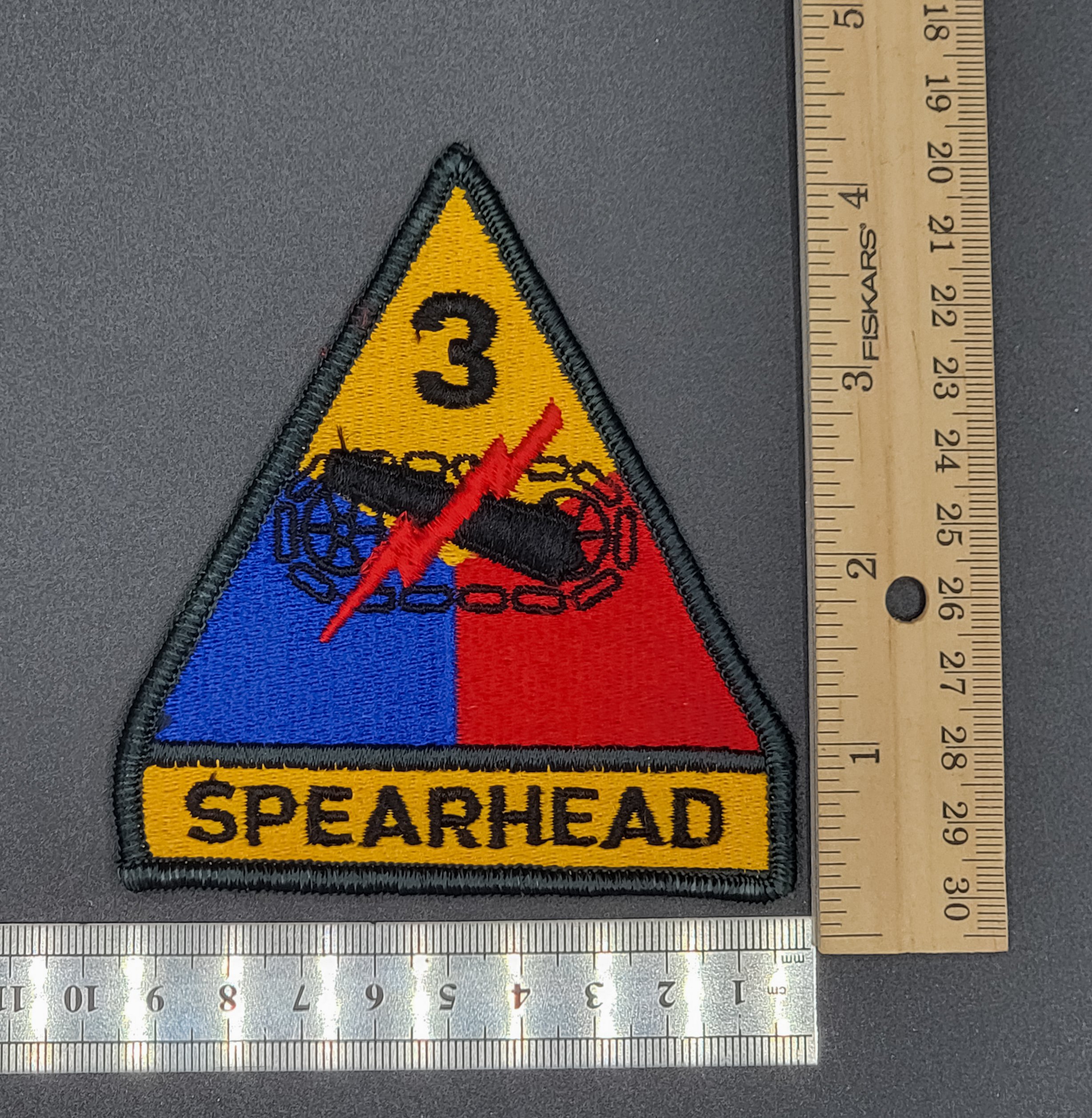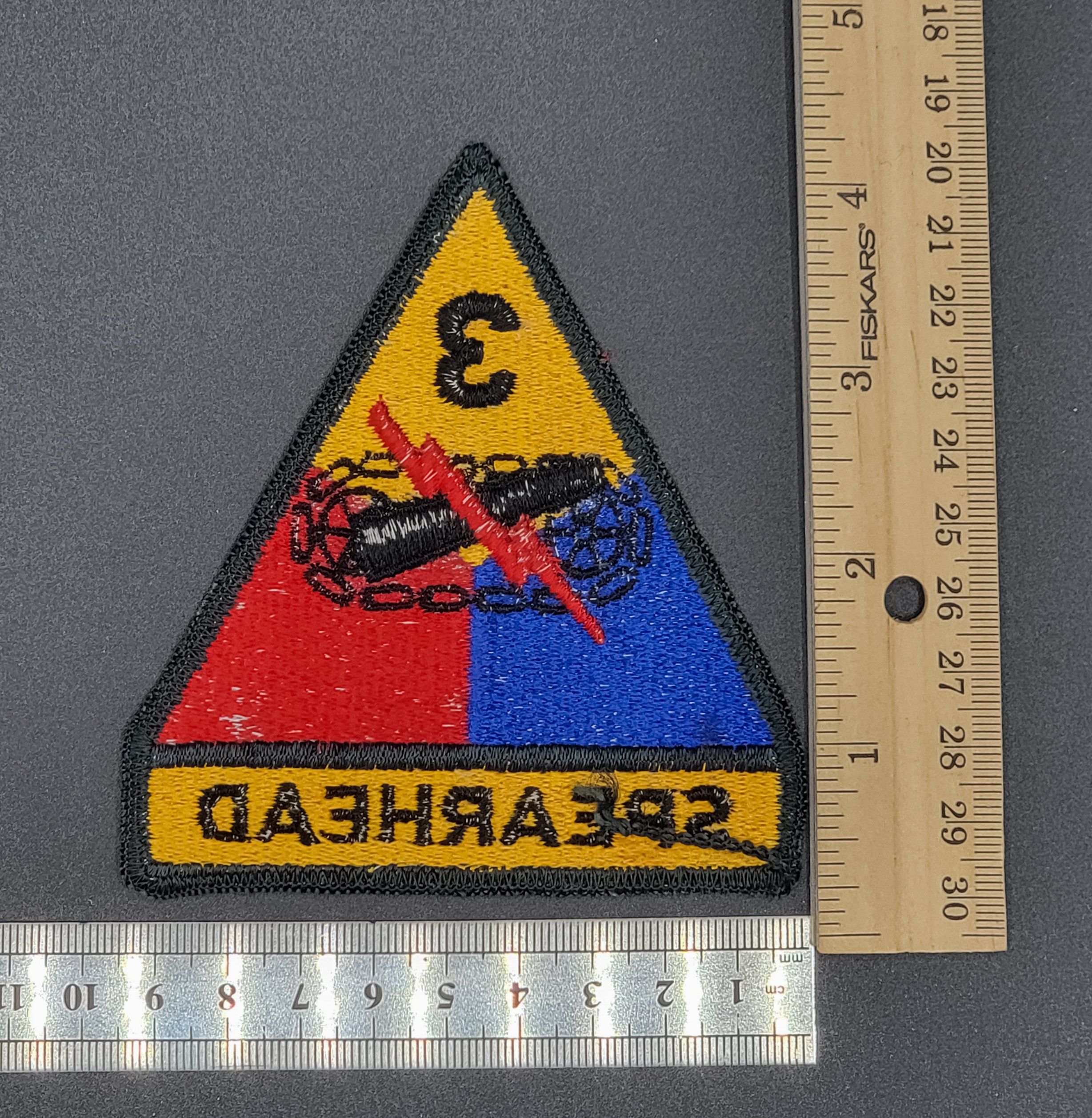3rd Armored Division "Spearhead"
The first elements of the 3rd Armored saw combat on 29 June in France, with the division as a whole beginning combat operations on 9 July 1944. During this time, it was under the command of VII Corps and XVIII Airborne Corps First Army, but was later reassigned to the XIX Corps under the Ninth Army and the for the rest of the war.
The division was the "spearhead" of the First Army through the Normandy Campaign, taking part in a number of engagements, most notably in the Battle of Saint-Lô, where it suffered significant casualties. After facing heavy fighting in the hedgerows and developing methods to overcome the vast thickets of brush and earth that constrained its mobility, the unit broke out at Marigny alongside the 1st Infantry Division and swung south to Mayenne. 3rd AD engineers and maintenance crews solved the problem of the Norman hedgerows by taking the large I-Beam invasion barriers from the beaches at Normandy and welding them on the fronts of Sherman tanks as large crossing rams. They would then hit the hedgerows at high speed, bursting through them without exposing the vulnerable underbellies of the tanks.
The division was next ordered to help close the Argentan-Falaise Pocket containing the German Seventh Army, which it finished by 18 August near Putanges. Six days later, the outfit had sped through Courville and Chartres and was approaching the banks of the Seine River. On the night of 25 August 1944, the division began the crossing of the Seine; once completed, the 3rd moved across France, reaching the Belgian border on 2 September 1944.
Liberated in the path of the division were Meaux, Soissons, Laon, Marle, Mons, Charleroi, Namur and Liège. The division cut off 40,000 Wehrmacht troops at Mons and captured 8,000 prisoners.
Hurtgen and the Bulge
On 10 September 1944, the 3rd, now nicknamed the "Spearhead Division", fired what it claimed was the first American field artillery shell onto German soil of the war. Two days later, it passed the German border and soon breached the Siegfried Line after taking part in the Battle of Hürtgen Forest.
The 3rd Armored Division fought far north of the deepest German penetration during the Battle of the Bulge. The division worked its way south in an attack designed to help wipe out the bulge and bring First Army's line abreast of General George S. Patton's Third Army, which was fighting northward toward Houffalize. It severed a vital highway leading to St. Vith and later reached Lierneux, Belgium, where it halted to refit.
The first elements of the 3rd Armored saw combat on 29 June in France, with the division as a whole beginning combat operations on 9 July 1944. During this time, it was under the command of VII Corps and XVIII Airborne Corps First Army, but was later reassigned to the XIX Corps under the Ninth Army and the for the rest of the war.
The division was the "spearhead" of the First Army through the Normandy Campaign, taking part in a number of engagements, most notably in the Battle of Saint-Lô, where it suffered significant casualties. After facing heavy fighting in the hedgerows and developing methods to overcome the vast thickets of brush and earth that constrained its mobility, the unit broke out at Marigny alongside the 1st Infantry Division and swung south to Mayenne. 3rd AD engineers and maintenance crews solved the problem of the Norman hedgerows by taking the large I-Beam invasion barriers from the beaches at Normandy and welding them on the fronts of Sherman tanks as large crossing rams. They would then hit the hedgerows at high speed, bursting through them without exposing the vulnerable underbellies of the tanks.
The division was next ordered to help close the Argentan-Falaise Pocket containing the German Seventh Army, which it finished by 18 August near Putanges. Six days later, the outfit had sped through Courville and Chartres and was approaching the banks of the Seine River. On the night of 25 August 1944, the division began the crossing of the Seine; once completed, the 3rd moved across France, reaching the Belgian border on 2 September 1944.
Liberated in the path of the division were Meaux, Soissons, Laon, Marle, Mons, Charleroi, Namur and Liège. The division cut off 40,000 Wehrmacht troops at Mons and captured 8,000 prisoners.
Hurtgen and the Bulge
On 10 September 1944, the 3rd, now nicknamed the "Spearhead Division", fired what it claimed was the first American field artillery shell onto German soil of the war. Two days later, it passed the German border and soon breached the Siegfried Line after taking part in the Battle of Hürtgen Forest.
The 3rd Armored Division fought far north of the deepest German penetration during the Battle of the Bulge. The division worked its way south in an attack designed to help wipe out the bulge and bring First Army's line abreast of General George S. Patton's Third Army, which was fighting northward toward Houffalize. It severed a vital highway leading to St. Vith and later reached Lierneux, Belgium, where it halted to refit.
The first elements of the 3rd Armored saw combat on 29 June in France, with the division as a whole beginning combat operations on 9 July 1944. During this time, it was under the command of VII Corps and XVIII Airborne Corps First Army, but was later reassigned to the XIX Corps under the Ninth Army and the for the rest of the war.
The division was the "spearhead" of the First Army through the Normandy Campaign, taking part in a number of engagements, most notably in the Battle of Saint-Lô, where it suffered significant casualties. After facing heavy fighting in the hedgerows and developing methods to overcome the vast thickets of brush and earth that constrained its mobility, the unit broke out at Marigny alongside the 1st Infantry Division and swung south to Mayenne. 3rd AD engineers and maintenance crews solved the problem of the Norman hedgerows by taking the large I-Beam invasion barriers from the beaches at Normandy and welding them on the fronts of Sherman tanks as large crossing rams. They would then hit the hedgerows at high speed, bursting through them without exposing the vulnerable underbellies of the tanks.
The division was next ordered to help close the Argentan-Falaise Pocket containing the German Seventh Army, which it finished by 18 August near Putanges. Six days later, the outfit had sped through Courville and Chartres and was approaching the banks of the Seine River. On the night of 25 August 1944, the division began the crossing of the Seine; once completed, the 3rd moved across France, reaching the Belgian border on 2 September 1944.
Liberated in the path of the division were Meaux, Soissons, Laon, Marle, Mons, Charleroi, Namur and Liège. The division cut off 40,000 Wehrmacht troops at Mons and captured 8,000 prisoners.
Hurtgen and the Bulge
On 10 September 1944, the 3rd, now nicknamed the "Spearhead Division", fired what it claimed was the first American field artillery shell onto German soil of the war. Two days later, it passed the German border and soon breached the Siegfried Line after taking part in the Battle of Hürtgen Forest.
The 3rd Armored Division fought far north of the deepest German penetration during the Battle of the Bulge. The division worked its way south in an attack designed to help wipe out the bulge and bring First Army's line abreast of General George S. Patton's Third Army, which was fighting northward toward Houffalize. It severed a vital highway leading to St. Vith and later reached Lierneux, Belgium, where it halted to refit.

